Centerpin Fishing For Salmon: Guide Tips and Tricks
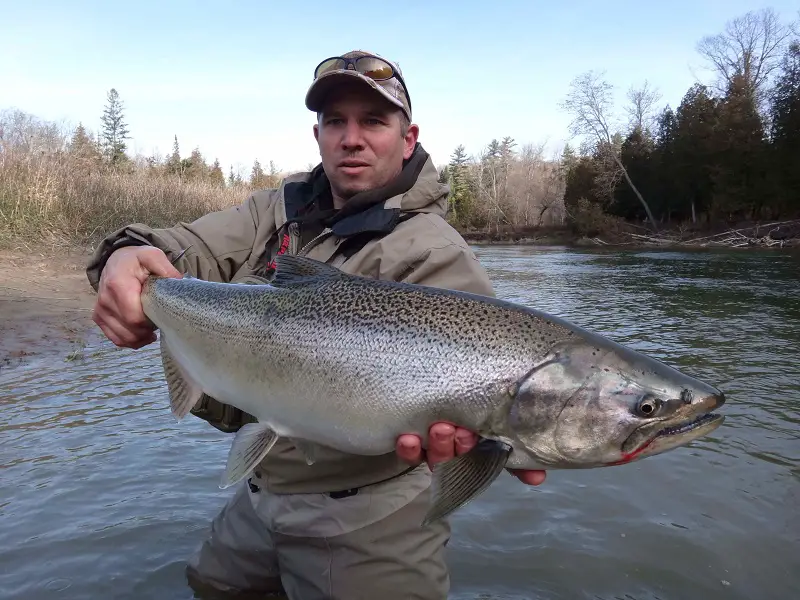
I’ve been centrepin fishing for salmon for over 30 years and guiding for salmon with Centerpin reels for over 20 years. It is arguably the most effective way to catch salmon with a bait in a river.
But, if you really want to catch more salmon, you need to know there is more to it than just casting out a float and bait and watching it go.
Based on my experience watching thousands of anglers fish, there are certain things that good anglers do that enable them to continuously catch ten times more salmon than other anglers.
Centerpin fishing for salmon is effective because it enables you to present a bait under a float in a very controlled manner, and it allows you to cover a lot of water. Good anglers can control the depth and speed of the bait better, make long drifts, and detect bites easily with a Centerpin and a good float. All this equals more salmon in the net.
Centerpin Fishing For Salmon
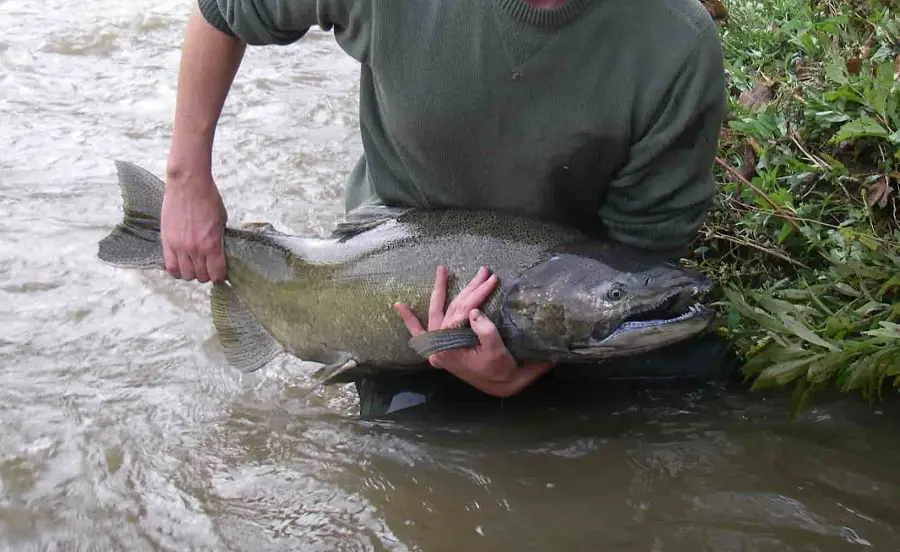
The key to catching salmon with any method is presentation, which means presenting your bait in the most natural manner possible!
When Centerpin fishing you are basically suspending your bait from a float, and you can set the depth by sliding the float up and down the line. The float allows you to keep your bait off the bottom while you let it drift down the river for potentially over 100 feet.
Anglers are now catching East Coast Atlantic salmon to West Coast Kings, Cohos, and Sockeye salmon in rivers using Centerpin rods and reels.
Centerpin Fishing Rivers
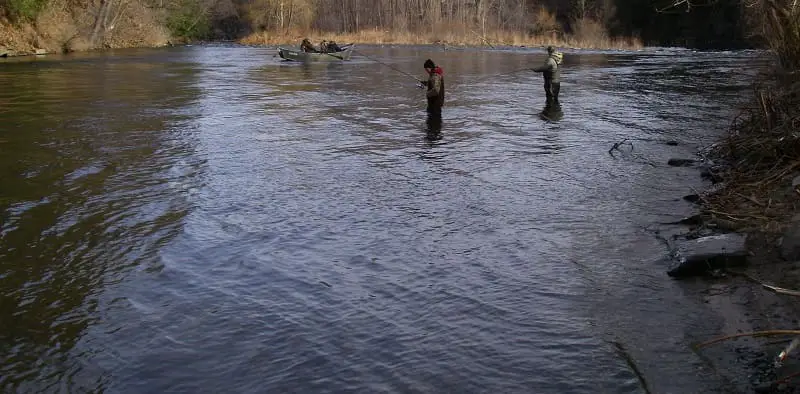
I have seen Salmon run up creeks so small I could jump across them. I’ve also seen them run up rivers that are hundreds of feet wide. I think Centerpin fishing is great in any river wider than 15 feet.
Under the right conditions, you could even fish for salmon in small creeks that are only 5 to 10 feet wide as long as there is some current to move the float and enough depth.
Centerpin fishing is very effective in slow-moving water as well as very fast water. Due to the leader setup and the float, the best spot in any river for Centerpin fishing are 3 feet deep up to about 12 feet deep.
It’s difficult to Centerpin fish for salmon in shallow water under three feet deep since the float will be too close to the bait, which can spook the salmon.
The Centerpin Reel
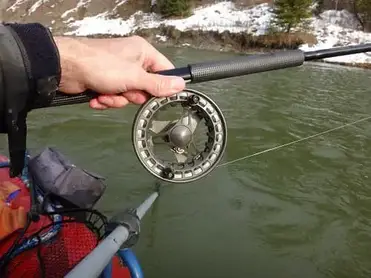
Centerpin fishing is basically float fishing, except that it is done with a reel called a Centerpin Reel.
Some guys will also call it a float reel.
The Centerpin reel is the most important part of the entire setup, and it’s this reel that makes Centerpin fishing so much more productive than other reels.
The Centerpin reel looks like a large fly reel, but a Centerpin reel has no drag system, it free-spools both ways, and it is meant for a regular fishing line that you might use on a spinning reel. Because centerpin reels have no drag system, this makes fighting big salmon and landing big salmon both challenging and a whole lot of fun.
Centerpin reels allow the anglers to get long, smooth drifts when using a float to present the bait to the fish.
A Centerpin reel works better for float fishing than spinning reels or bait cast reels because the Centerpin reel allows you to feed line out effortlessly and smoothly and enables you to control the speed of the line so that you can control the speed of your float and the speed of the bait, and all that provides you with the best presentation possible.
I have used and guided with spinning reels and with baitcasting reels when float fishing and in most cases, those reels just can not do the job as well as a Centerpin reel can.
On my page, 25 Best Float Fishing Reels Of 2024: Buyers Guide, I discuss over twenty of the best centerpin reels.
Also, I have a page All About Centerpin Reels where I discuss:
- The four best Centerpin reels.
- Bearings versus bushing Centerpin reels.
- Centerpin Reel Sizes: What’s the difference?
- Left hand or right hand – what’s best for you (you might be surprised).
- Centerpin reel weight and build.
- Custom Centerpin reels versus brand name reels ( my thoughts).
- What is reel start-up?
- Best lines for Centerpin reels.
- How to set up your centerpin reel.
The Centerpin Rod

Long rods are the name of the game when it comes to catching salmon with a Centerpin reel. An average size Centerpin rod is around 13 feet with a line rating of 8 to 16 lbs for Great Lakes fishing and around 12 to 20 pounds for very big rivers and for West Coast salmon.
For smaller salmon streams, some guys will use 11 or 12-foot rods, and for much larger rivers 14 to 15-foot rods can be used.
Two good centerpin rods for Great Lakes salmon are the 12-foot Lamiglas Redline H HS12CS and the Raven IM8 Float Rod. I have used both of these rods all around the Great Lakes region and on the West Coast. They are light, strong, and are excellent on salmon.
The reason we use such long rods when Centerpin fishing is that the longer rod allows us to keep the line up off the water on long drifts which allows us to have better line control and float control and an overall better presentation.
The long Centerpin rods act like a giant shock absorber so that we can use lighter leaders on big fish that might be line shy. The long rods also protect the leader on hook sets. Not to mention, these long Centerpin rods are also fun to fish with.
You also want a Centerpin rod that suits the rivers that you fish.
Be sure to check out my page, 11 Best Rods For Salmon, which is where I cover things like:
- Best Centerpin rods
- Centerpin rod length
- Best rods for small rivers, medium rivers, and large rivers
- Best Centerpin rod action
- Rod sizing chart
- Two-piece rods versus three-piece Centerpin rods
- Best Centerpin rod handle types
- Best float rods for spin fishing
The Centerpin Line

I keep reading on chat boards and hearing that the line you use on a Centerpin doesn’t really matter.
Let me tell you from experience that after using just about every line ever recommended, the line you use on a Centerpin reel matters a lot.
One thing you need to make sure of when buying a line for centerpin fishing is that the line is supple, is not too heavy, and that it is buoyant. You also need to be sure the line is strong enough not to break but light enough that it fishes well.
Raven Mainline
The best Centerpin line I have used is the Raven Tackle Mainline. This line is made for Centerpin fishing and has all the qualities I want and need in a Mainline to maximize my ability to fish well and catch more fish.
- Great Lakes salmon: 10 to 12 -pound Raven Mainline in yellow
- Small Rivers: On smaller rivers where I can easily walk with the salmon, I prefer 10-pound line.
- Large Rivers: On larger Great Lakes rivers, I like to use 12-pound line.
- West Coast Salmon: Smaller west coast river salmon 12 to 14-pound line
- Large West Coast Rivers: 14 to 16-pound line
Remember, the long rods act like a big shock absorber, and there are times when light leaders are necessary, and therefore very heavy lines are not required.
I also like to use bright-colored lines (like the line in the above picture) because these brightly colored lines can have a lot of advantages as long as you set up your leader properly.
Check out my page Best Centerpin Line: What The Guides Use for all the lines that I have used, tested, and recommend.
Terminal Tackle Used For Centerpin Fishing
When it comes to Centerpin fishing and float fishing with centerpin reels, we use all the same terminal tackle, which includes floats, leaders, swivels, weights, hooks, and baits.
The Best Centerpin Floats

Some anglers will call them a bobber, but the correct term when river fishing is a float. That is where the name float fishing comes from.
Floats are a key component of Centerpin fishing, but not all floats are good for centerpin fishing.
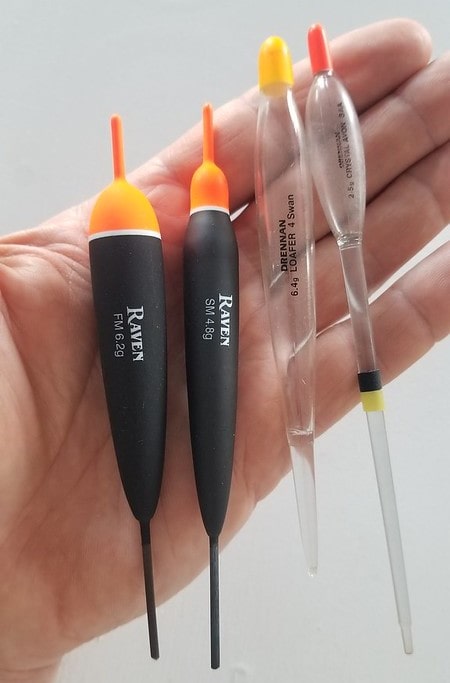
For float fishing in rivers and creeks, you want a longer, narrow float designed specifically for river fishing.
These floats have specific advantages and are much better for river fishing, but only if you know how to utilize them properly.
You also want to match the size of the float to the size of the river and the amount of weight you will be fishing.
The amount of weight will depend on the depth and velocity of the river.
On small to mid-sized rivers, a 5 to 8-gram float should be plenty. On very large rivers, you may need to go up to a 12 to 16-gram float.
I have an entire page on the Best Floats For Centerpin Fishing – HERE. I talk about which floats to use in different rivers and under different river conditions and some tips on how to maximize your success with them.
Leaders For Fishing Salmon

The leader attaches to the mainline, where you attach your weights, hooks, and baits.
I highly suggest that you use the right leader and know what the right size leader is for the type of river and the type of fish you fish for.
The mainlines that I recommended above both have a thickness or diameter of about 0.28mm to 0.30mm. The thickest part of the leader setup should be slightly less at about 0.26mm to 0.28mm in diameter on what is called the shot line. See below.
The bottom section of the leader, where the bait goes, is critical. Ten and 12-pound leaders of diameter 0.22mm for small streams, and 0.24mm to 0.26mm are usually perfect for Great Lakes salmon.
For bigger rivers like the Niagara River or on the west coast rivers, 14 to 16-pound leaders are better.
There are all kinds of leaders to choose from, but I narrow it down for you and explain the difference between the best leaders, and the right sizes, as well as teach you how to set the leader up like a pro on my Best Leaders For Float Fishing page.
Centerpin Leader Setup For Salmon
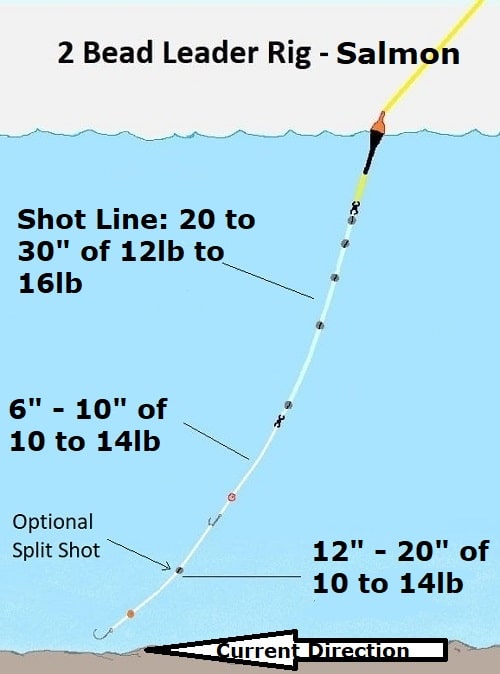
The right leader setup will help you get the proper leader angles and a better presentation of your bait.
The diagram above shows a two-bait centrepin leader setup for salmon.
However, you can easily remove one hook and stick to a single bait.
In fact, laws in some areas only allow one bait.
For the leader setup, I use two swivels, two different line diameters, spit shots, and a great hook ( or two) for my leader setup.
I also use something called a “Shot Line,” which is critical if you use thick mainlines, or if you use colored mainlines. A shot line is a section at the top of the leader. This section can be 16″ to 36″ depending on the size and depth of the river I fish.
The shot line is basically a separate portion of the leader where all the weights go, which you can see in the above diagram. If you set this up properly, you will improve your success. For my leader, I have a swivel at the top and bottom of the shot line.
There is a lot that goes into my leader setup, but I have proven the effectiveness of this leader over the last 30 years of centerpin fishing for steelhead, salmon, and trout.
To see my other leader setups for shallow and deeper water, including shot line lengths, check out my page Leaders: Best Float Leader And Proven Setups.
Swivels And Weights For Centerpin Fishing

I use small swivels to attach the leader to the mainline. These swivels are very small but strong, and it’s important to use good quality swivels like the size 8 Spro Power Swivel 50 pound. Cheap swivels will break on big hard fighting salmon.
You should be using split shots in sizes BB to AAA for most salmon fishing situations. My favorite are Sure Shots. Do not use shiny silver split shots with removable ears.
Best Hooks For Float Fishing

The right hooks are really important for salmon. Having the wrong hook can lead to all kinds of problems and even no fish.
A hook that is too big may be seen by the salmon and then ignored, or a large hook could cause problems with your presentation by not allowing your baits to drift naturally or cause the bait to sink and snag up more.
A hook that is too small can break or bend or come out too easily, and you could lose a fish of a lifetime.
Also, gap size of the hook is important. The right gap size or gap shape can help your hook stay lodged in the salmon’s mouth.
I like and use the Raven Specimen hooks, but many anglers like the Gamakatsu Octopus hook. Both are good options. For large rivers, when fishing dirtier water, or when using larger baits, size 2 or 4 should be perfect.
But when fishing in smaller rivers, clear water, or slow water where stealth is required, a size 8 or 6 hook is a better option.
The size of the bait will determine the hook size, and the hook gap, water clarity, and even the size of the salmon can all influence my decision on which hook to use.
I discuss all of this on my page on the 4 Best Hooks For Float Fishing for more details and my list of the best hooks to use in all situations.
The Best Baits For Float Fishing
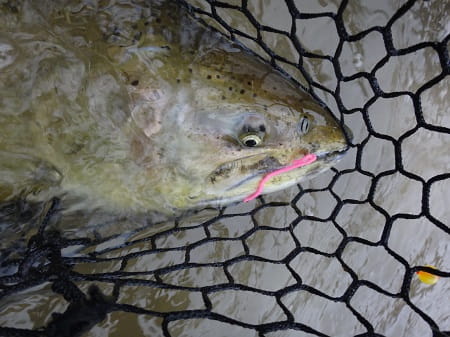
Using the right bait at the right time will greatly increase the amount of fish you catch.
In most river situations, you can’t go wrong with live or plastic worms, spawn bags, skien, and flies, but there are other really good baits to check out on my page on the Best Baits For Salmon Fishing On Rivers And When To Use Them.
The 4 Fundamentals Of Centerpin Fishing

Having the right gear, the right setup, and the right baits is only half of what is required to be a great centerpin angler.
Catching salmon when centerpin fishing takes skill and knowledge along with practicing the right things. It has been said before that presentation is the key, but I don’t always agree.
I personally believe that everything needs to be right, and not just the presentation.
A great presentation done with the wrong bait, wrong hook, wrong setup, or a leader so thick that the salmon see it from five feet away will only get you so far.
In fact, a great presentation with the wrong-sized leader or the wrong bait is often useless.
You have to get it all right. That’s what guides do and is the reason why they catch more salmon than the average angler.
Set Up For More Success

One of the fundamentals is how you set up your rod, reel line, leader, and even how you put on your bait.
Setting up your leader wrong can mean no fish at the end of the day, even if you are good at the other three fundamentals.
Also, using a reel that doesn’t work well or using an old line or a line that is too heavy will prevent you from catching fish.
Everything from the rod and reel down to the bait needs to be just right, but also being comfortable, dry, safe, and even having the right net can help.
Make sure you have all the stuff you need. Check out my page, Centerpin Fishing Gear: A Guide Recommended List.
Cover The Water Effectively

You can’t just stand anywhere when Centerpin fishing for steelhead. You need to be standing in the right spot. Most often, as float fishing anglers, we fish from the top down so we can cover the water effectively.
This means positioning yourself at the top of the pool, landing your float right where it goes from shallow to deeper and usually close to you, and then making long drifts from the top of the pool to the bottom of the pool is the best way to do it.
Once your drift is complete, you want to systematically move each drift a little further over, about a foot at a time until the entire pool is completely covered.
You can see how this is done with the orange lines in the above picture.
Normally I would have had the angler in the above picture fish from the bank but it had too many hanging trees. Or, if he were standing in the middle of the river like in the picture, I would have had him stand back about 15 feet so his rod tip was about where the first line in the middle of the river is, but the water was too fast for him in the middle to stand safely, so he moved to the safest spot.
Sometimes, you just need to make exceptions, but try your best to be in the right spot.
The main thing is to cover the water in lines and don’t miss a spot. Unfortunately, many anglers don’t do this very well, and they miss a lot of fish. I discuss this in more detail on my page, Effectively Covering The Water When Float Fishing.
Find The Bottom When Float Fishing For Salmon

I just discussed covering the water from one side to the other, but covering the water can also mean from top to bottom, or surface to bottom.
For salmon fishing in rivers, they are usually very close to the bottom, and much of the time it’s very difficult to tell how deep they are. This means you need to get your bait down to the fish if you want to catch them.
However, at times I have seen them suspending 3 feet down in a 10-foot deep hole, and if your bait is on the bottom you won’t catch any fish.
Many guys make the mistake of either dragging their baits along the bottom or drifting their bait too far over the heads of the fish, and they rarely make adjustments to their floats. I tell all my students that the first thing they want to do in every spot that the fish is to find the bottom.
Having the perfect leader set up, and the best bait and then making a great drift is useless if your bait is five feet over their heads.
Find the bottom, and you will often find the salmon. It’s actually rare to see the salmon suspended more than a few feet off the bottom, and far more common for them to be a few inches off the bottom.
To find the bottom, I start by guessing the depth of the spot just by looking at the pool and trying to see if I can see the bottom or not, then I adjust my float to what I think the depth might be, I usually start shallower than deeper and make a drift.
If I can’t see the bottom, I may start with a 6-foot leader and see what happens.
The first drift is to see if the bait catches the bottom or if the float keeps tilting downriver fast. If this happens, I’m likely dragging my bait along the bottom.
If the float drifts freely without any tilting or bumping rocks, I just make it a foot deeper and try again; then I keep repeating and making it one foot longer until I start hitting bottom.
Once you find the bottom, you can shorten up your leader by 12 to 16 inches, and then make a good clean and controlled drift, and then start covering the water one foot at a time as I describe above.
Using the right float and using the right bait can really help you learn how to find the bottom better.
A sensitive float like the ones I recommend on my best floats page will help you find the bottom easier. Round floats suck for this!
A heavier bait that gets down fast and stays down and one that will drag and catch the bottom more often will also help you determine if you are on the bottom or not. A very light bait will not work so well.
There is more to finding the bottom effectively and some tricks you should know about. For more information, check out my page, How To Know How Deep To Set Your Float – 2 Easy Ways
Centerpin Fishing: Speed Control

Speed control is the most important of all the Centerpin fundamentals. I didn’t realize how important it actually was until I started guiding and had the opportunity to watch hundreds of anglers fish and not catch any fish.
When I started guiding, I would wonder why one angler would catch all the fish even though both of them used the same setup and even the same bait. Was it just luck? Eventually, I figured it out and realized that one angler was simply controlling his speed better.
Now I make sure that my clients always know to control their speed and I emphasize the importance of this. To control your speed when float fishing, I do something called trotting.
Trotting Your Float For Better Presentation

There is a thing in centerpin fishing and float fishing called trotting, or some call it checking your float, and it is a very important concept to learn.
Trotting is how you control your speed to get your bait moving at a natural speed as it travels through the strike zone.
You can trot much better with a Centerpin reel than any other reel, which is why I believe that the Centerpin reel is superior to any other reel used in float fishing.
Some anglers reading this already know what trotting or checking your float is but, I would bet 9 out of 10 didn’t know the real reason why trotting actually works so well. Did you?
When Centerpin fishing and float fishing with spinning reels, trotting, or checking your float is simply holding your float back so it moves slower than the surface current.
It’s not so you present your bait first and before the float.
The real reason why trotting works so well is that if you hold your float back just enough so you can match the bottom speed better.
Matching the bottom speed means that your bait moves in the lower water column at a speed that matches everything else that is drifting through that area, and therefore, your bait looks more natural to the fish. It also gives the fish more time to see your bait and react to it.

To do this well, you want to hold your float back just a little to get the right angle. You can do this by applying pressure or tapping the spool of the Centerpin reel.
Once you get that proper angle, you work your reel and control the speed of the line coming off the reel to maintain that angle throughout the entire drift.
You want to try to achieve the best angle as seen in the diagram above. Without going into full details on why this angle is the best, just trust me on this one and do it.
To learn more about this very critical part of float fishing, check out my page Float Fishing: Controlling Your Speed For More Fish.
Understanding Salmon Holding Water and Behavior
There are a few other bonus tips I will provide that are really important if you want to be successful catching salmon when Centerpin fishing.
Knowing how to read the water is important when fishing for salmon in a river. Knowing about travel routes and salmon holding water will also greatly increase the amount of salmon you will catch.
These holding spots will change throughout the fall season depending on conditions such as water levels, water clarity, time of day, and light.
I also find that at times the baits they eat can be different. As an example, when the water is low and clear, often, salmon will all be holding the deepest pools during high sun and might only eat a tiny little bait like a stonefly nymph. But, as it gets close to dusk, and through the night, they will start to move under the low light, and they can be found in pools, pockets, and riffles sections.
But under high water conditions, the salmon can literally be anywhere, or they may even be seeking out the seams and slower edges closer to the banks.
I also find that when they are in the river for only a few hours, they don’t like to stop and eat so they just blast through the lower sections of the river. But after a day or two in the river, they slow down and hold longer in the pools. These holding salmon are much easier to catch.
Timing Runs
Another thing that you should know is how to time the salmon runs. Anglers who do this well will be the lucky guys who will catch 10+ salmon a day simply because they are on the water when the fish come in or when the salmon are most abundant.
Knowing how to time the runs can make a huge difference.
Knowing this will allow me as a guide to be on the right river on the right day. I can fish a quick clearing river one day and catch a ton of fish and then two days later be on another river that has just cleared and hammer them.
I record what color and clarity the river is based on the levels shown on the charts. I discuss all of this on my page How To Catch Salmon In A River: Guides Explain Methods And More….
New To Centerpin Fishing
There are times when there will be steelhead and trout mixed in with the salmon so you might want to check out my page Centerpin Fishing For Steelhead as well.
Also, if you are new to Centerpin fishing, check out my page Centerpin Fishing For Beginners.
Tight Lines,
Graham

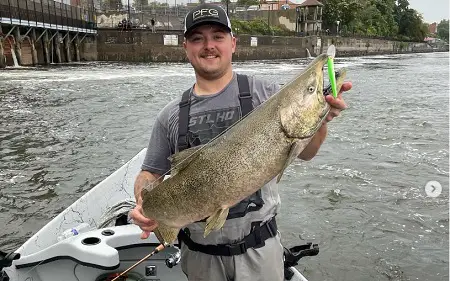
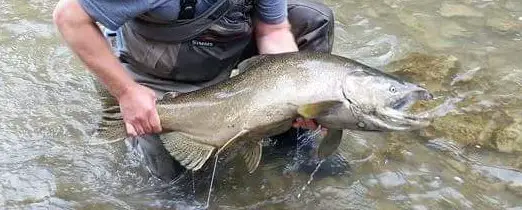
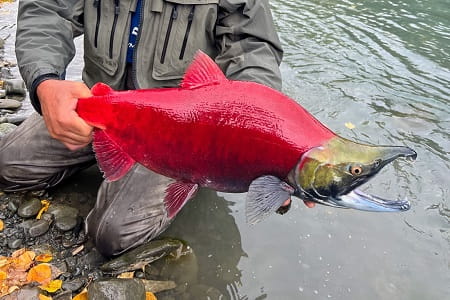
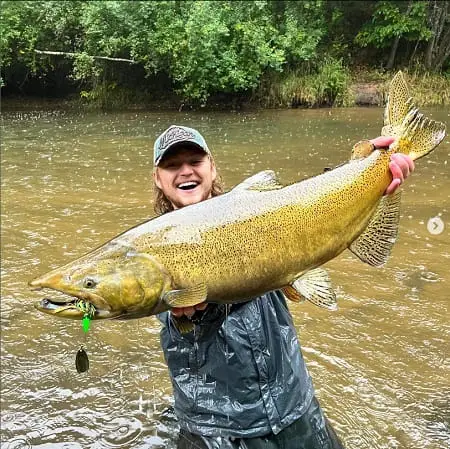
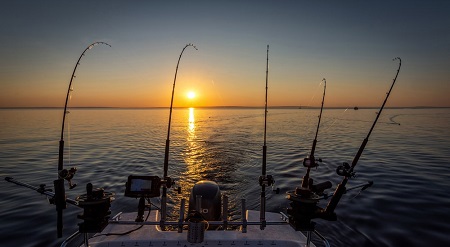
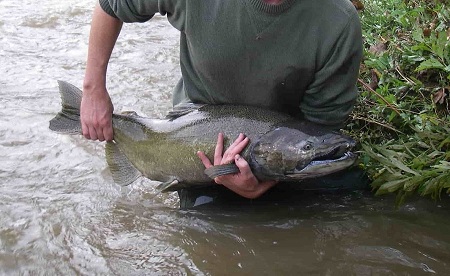
Hi Graham 🙂
Thanks again for this amazing content! Soooo helpful!
I have a question regarding centerpin reels. I’m planning on getting the Raven Matrix fully ported. Could you please tell me what size reel you would recommend? Regular or XL? Fyi, I will be using 10,6 or 11,3 feet rod.
Thx!
Olivier
Hey Olivier,
That’s a great reel, I would go with the regular-size reel.
Best of luck buddy,
Graham
Awesome! Thank you Graham 🙂
Take care!
Olivier
Hi Graham,
I’m debating between getting the Raven T4 or the Matrix fully ported.
I read 100 times you review on the Matrix fully ported and know how much you love it. The reason why I am thinking about the T4 is because of the clicker system that is machined directly into the backplate and it also has the abec 5 bearings.
Personally which one would you go for? Do you think that the T4 specs vs the fully ported is worth the extra $$.
Thx in advance for your help this!
Olivier
Hey Oliver,
Sorry for the delay, I just got back from a backwoods fishing trip.
The T4 is a slightly better reel and if it’s in your budget you will likely enjoy it more. However, there is nothing wrong with the Fully Ported reels and I never had an issue with the clicker. What I really like about the fully ported reels is they are a decent price and they work flawlessly which is good for a guy like me that needs multiple reels for clients.
Either way, they are two very good reels.
Good Luck.
Graham,
Hello,
Is it realistic to centerpin (float) fish for salmon while wading up at the salmon river in pulaski? All I see online is the flossing method. However I would prefer to catch them with my 13′ centerpin setup.
Thanks for the advice and thank you very much for all the information on this site. I have learned a lot!
Hi Ray,
In the bigger deeper runs, a Centerpin can be very effective.
Good Luck.
Graham